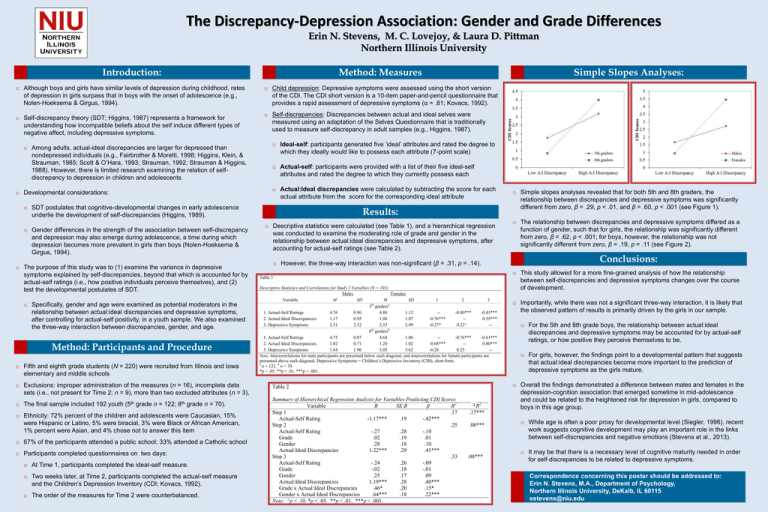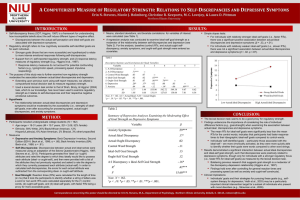Stevens, E. N., Lovejoy, M. C., Pittman, L. D. (2013, November). The Discrepancy-Depression Association: Gender and Grade Differences . Poster presented at the annual meeting of the Association for Behavioral and Cognitive Therapies, Nashville, TN.
advertisement

The Discrepancy-Depression Association: Gender and Grade Differences Erin N. Stevens, M. C. Lovejoy, & Laura D. Pittman Northern Illinois University Introduction: Method: Measures o Although boys and girls have similar levels of depression during childhood, rates of depression in girls surpass that in boys with the onset of adolescence (e.g., Nolen-Hoeksema & Girgus, 1994). o Child depression: Depressive symptoms were assessed using the short version of the CDI. The CDI short version is a 10-item paper-and-pencil questionnaire that provides a rapid assessment of depressive symptoms (α = .81; Kovacs, 1992). o Self-discrepancy theory (SDT; Higgins, 1987) represents a framework for understanding how incompatible beliefs about the self induce different types of negative affect, including depressive symptoms. o Among adults, actual-ideal discrepancies are larger for depressed than nondepressed individuals (e.g., Fairbrother & Moretti, 1998; Higgins, Klein, & Strauman, 1985; Scott & O’Hara, 1993; Strauman, 1992; Strauman & Higgins, 1988). However, there is limited research examining the relation of selfdiscrepancy to depression in children and adolescents. o Self-discrepancies: Discrepancies between actual and ideal selves were measured using an adaptation of the Selves Questionnaire that is traditionally used to measure self-discrepancy in adult samples (e.g., Higgins, 1987). o Ideal-self: participants generated five ‘ideal’ attributes and rated the degree to which they ideally would like to possess each attribute (7-point scale) o Actual-self: participants were provided with a list of their five ideal-self attributes and rated the degree to which they currently possess each o Actual:Ideal discrepancies were calculated by subtracting the score for each actual attribute from the score for the corresponding ideal attribute o Developmental considerations: o SDT postulates that cognitive-developmental changes in early adolescence underlie the development of self-discrepancies (Higgins, 1989). o Gender differences in the strength of the association between self-discrepancy and depression may also emerge during adolescence, a time during which depression becomes more prevalent in girls than boys (Nolen-Hoeksema & Girgus, 1994). o The purpose of this study was to (1) examine the variance in depressive symptoms explained by self-discrepancies, beyond that which is accounted for by actual-self ratings (i.e., how positive individuals perceive themselves), and (2) test the developmental postulates of SDT. o Specifically, gender and age were examined as potential moderators in the relationship between actual:ideal discrepancies and depressive symptoms, after controlling for actual-self positivity, in a youth sample. We also examined the three-way interaction between discrepancies, gender, and age. Method: Participants and Procedure o Fifth and eighth grade students (N = 220) were recruited from Illinois and Iowa elementary and middle schools o Exclusions: improper administration of the measures (n = 16), incomplete data sets (i.e., not present for Time 2; n = 9), more than two excluded attributes (n = 3), o The final sample included 192 youth Simple Slopes Analyses: (5th grade n = 122; 8th grade n = 70). o Ethnicity: 72% percent of the children and adolescents were Caucasian, 15% were Hispanic or Latino, 5% were biracial, 3% were Black or African American, 1% percent were Asian, and 4% chose not to answer this item o 67% of the participants attended a public school; 33% attended a Catholic school o Participants completed questionnaires on two days: o At Time 1, participants completed the ideal-self measure. o Two weeks later, at Time 2, participants completed the actual-self measure and the Children’s Depression Inventory (CDI; Kovacs, 1992). o The order of the measures for Time 2 were counterbalanced. Results: o Descriptive statistics were calculated (see Table 1), and a hierarchical regression was conducted to examine the moderating role of grade and gender in the relationship between actual:ideal discrepancies and depressive symptoms, after accounting for actual-self ratings (see Table 2). o However, the three-way interaction was non-significant (β = .31, p = .14). Table 1 Descriptive Statistics and Correlations for Study 2 Variables (N = 192) Males Females Variable M SD M SD 1 2 3 5th gradersa 1. Actual-Self Ratings 4.76 0.96 4.80 1.12 --0.80*** -0.43*** 2. Actual:Ideal Discrepancies 1.17 0.95 1.08 1.07 -0.76*** -0.55*** 3. Depressive Symptoms 2.31 2.52 2.53 2.99 -0.27* 0.22^ -8th gradersb 1. Actual-Self Ratings 4.75 0.87 4.64 1.06 --0.76*** -0.61*** 2. Actual:Ideal Discrepancies 1.02 0.71 1.20 1.02 -0.68*** -0.80*** 3. Depressive Symptoms 1.84 1.90 3.05 3.62 -0.28 0.25 -Note. Intercorrelations for male participants are presented below each diagonal, and intercorrelations for female participants are presented above each diagonal. Depressive Symptoms = Children’s Depressive Inventory (CDI), short form. a n = 122. b n = 70. *p < .05. **p < .01. ***p < .001. Table 2 Summary of Hierarchical Regression Analysis for Variables Predicting CDI Scores Variable B SE B β R2 Step 1 .17 Actual-Self Rating -1.17*** .19 -.42*** Step 2 .25 Actual-Self Rating -.27 .28 -.10 Grade .02 .19 .01 Gender .28 .18 .10 Actual:Ideal Discrepancies 1.22*** .29 .41*** Step 3 .33 Actual-Self Rating -.24 .26 -.09 Grade -.02 .18 -.01 Gender .25 .17 .09 Actual:Ideal Discrepancies 1.19*** .28 .40*** Grade x Actual:Ideal Discrepancies .46* .20 .15* Gender x Actual:Ideal Discrepancies .64*** .18 .22*** Note: ^p < .10. *p < .05. **p < .01. ***p < .001. ∆ ∆R2 .17*** .08*** .08*** o Simple slopes analyses revealed that for both 5th and 8th graders, the relationship between discrepancies and depressive symptoms was significantly different from zero, β = .29, p < .01, and β = .60, p < .001 (see Figure 1). o The relationship between discrepancies and depressive symptoms differed as a function of gender, such that for girls, the relationship was significantly different from zero, β = .62, p < .001; for boys, however, the relationship was not significantly different from zero, β = .19, p = .11 (see Figure 2). Conclusions: o This study allowed for a more fine-grained analysis of how the relationship between self-discrepancies and depressive symptoms changes over the course of development. o Importantly, while there was not a significant three-way interaction, it is likely that the observed pattern of results is primarily driven by the girls in our sample. o For the 5th and 8th grade boys, the relationship between actual:ideal discrepancies and depressive symptoms may be accounted for by actual-self ratings, or how positive they perceive themselves to be. o For girls, however, the findings point to a developmental pattern that suggests that actual:ideal discrepancies become more important to the prediction of depressive symptoms as the girls mature. o Overall the findings demonstrated a difference between males and females in the depression-cognition association that emerged sometime in mid-adolescence and could be related to the heightened risk for depression in girls, compared to boys in this age group. o While age is often a poor proxy for developmental level (Siegler, 1996), recent work suggests cognitive development may play an important role in the links between self-discrepancies and negative emotions (Stevens et al., 2013). o It may be that there is a necessary level of cognitive maturity needed in order for self-discrepancies to be related to depressive symptoms. Correspondence concerning this poster should be addressed to: Erin N. Stevens, M.A., Department of Psychology, Northern Illinois University, DeKalb, IL 60115 estevens@niu.edu



